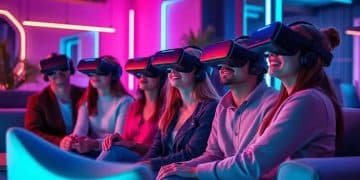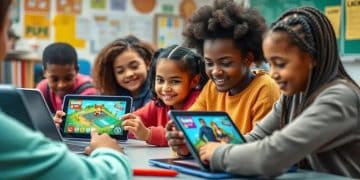VR learning environments trends that you need to know
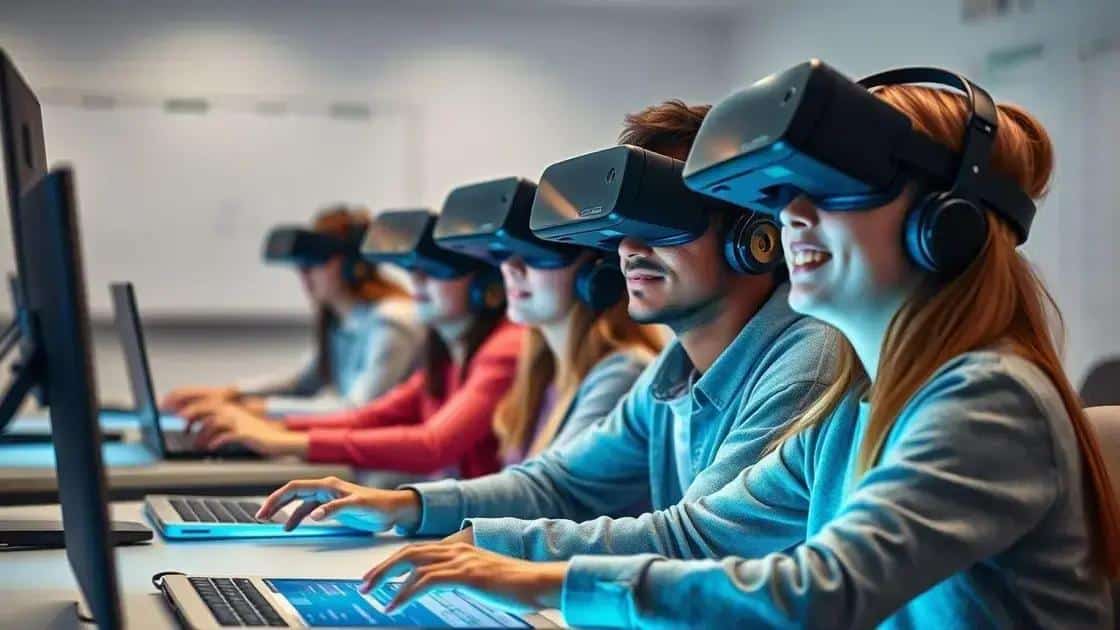
VR learning environments trends are reshaping education by enhancing engagement, personalizing learning experiences, and facilitating global collaboration among students.
VR learning environments trends are shaping the future of education, offering immersive experiences that captivate students. Have you ever wondered how these technologies can redefine traditional learning?
The evolution of VR in education
The evolution of VR in education has been remarkable and transformative. It has changed how students interact with learning materials. Virtual reality creates immersive experiences that traditional classrooms cannot provide.
As technology has advanced, VR has become more accessible. Schools now have the ability to integrate this technology into their curriculums. This means students can explore environments that are impossible to visit in real life. Imagine studying the solar system not just in a textbook, but by actually experiencing it in 3D!
Key milestones in VR education
VR technology has experienced several key developments:
- The introduction of affordable VR headsets
- Improved software for educational purposes
- Growing acceptance of VR in academic settings
- Enhanced engagement with interactive content
These milestones pave the way for further integration of VR learning environments in classrooms. Students can now participate in virtual field trips, science experiments, and historical reenactments, all from their desks.
With VR, educators can create highly engaging lessons. The ability to observe concepts in a 3D space helps students grasp complex ideas. Consider how anatomy lessons change when students can walk through a body or witness the intricacies of cells up close.
Impact on student engagement
Research shows that VR learning environments significantly boost student engagement. When students are actively involved in their learning, they retain information better. Virtual reality makes learning not just effective but also enjoyable.
Teachers also have the ability to adapt lessons quickly, providing personalized learning experiences. This means each student can explore subjects at their own pace. VR allows them to dive deeper into topics that interest them. This approach caters to different learning styles, making education more inclusive.
The future of VR in education looks bright as technology continues to advance. As we witness more innovations, the possibilities for engaging and interactive learning will only expand. Schools adopting these technologies will prepare students for a future where immersive experiences are the norm.
Key benefits of VR learning environments
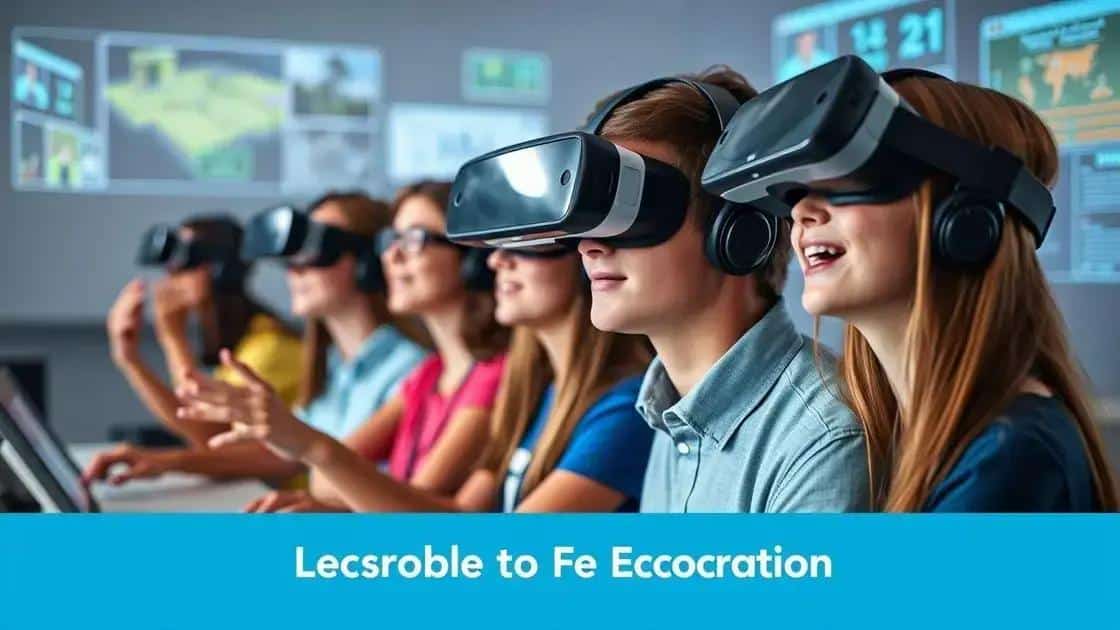
The key benefits of VR learning environments are numerous and impactful. These immersive spaces drastically change how students engage with learning materials. By using virtual reality, educators can facilitate deeper understanding and retention of information.
One major advantage is the ability to create experiential learning opportunities. For instance, students can explore distant planets or ancient civilizations without leaving their classroom. This hands-on approach captivates students and makes lessons more memorable.
Enhanced Engagement
When students participate in VR learning environments, their engagement levels rise significantly. They feel like active participants rather than passive recipients of information.
- Boosts motivation to learn
- Increases attention span
- Provides real-time feedback
- Encourages collaboration among students
Another benefit is the customizable nature of VR content. Teachers can tailor lessons to meet the unique needs of their students. This flexibility allows students to learn at their own pace, which fosters a more inclusive learning atmosphere.
VR learning environments also help in developing critical thinking skills. By presenting scenarios that require problem-solving, students can practice these essential skills in a safe space. For instance, they can simulate scientific experiments or historical events, gaining insights in a risk-free setting.
Improved Knowledge Retention
Studies indicate that students retain information better when they have immersive experiences. VR allows them to visualize complex concepts, transforming abstract ideas into concrete experiences.
Moreover, the rich sensory involvement facilitated by virtual reality enhances memory recall. When information is coupled with a vivid experience, students are more likely to remember what they learned. This phenomenon is particularly helpful in subjects like history, science, and art.
As educational institutions explore the advantages of VR learning environments, they are likely to notice improved outcomes. By integrating these technologies, schools can create a dynamic and engaging atmosphere that promotes active learning and critical engagement.
Challenges in implementing VR in classrooms
Challenges in implementing VR in classrooms are significant hurdles that educators face. Although the technology is promising, there are several obstacles that can hinder its effective use in education. Understanding these challenges is crucial for successful integration.
One major obstacle is the cost associated with acquiring and maintaining VR learning environments. Schools may struggle with budgeting for new hardware, software, and ongoing maintenance. This can limit access, especially in underfunded districts.
Technical issues
Another challenge is the technical knowledge required to operate VR equipment. Teachers need thorough training to effectively use VR tools in their lessons. Without proper training, the technology can be underutilized, reducing its potential impact.
- Hardware malfunctions can disrupt the learning process.
- Software updates may be necessary, adding complexity.
- Access to reliable internet connections is essential.
- Compatibility issues between devices can arise.
Additionally, the physical space required for VR activities can be an issue. Classrooms may not have enough space for students to move around safely while wearing headsets. This creates a need for careful planning and adjustments in classroom design.
Moreover, there are concerns about student discomfort and motion sickness during virtual experiences. Not all students adapt well to VR, which can lead to decreased participation among some learners. Teachers must be mindful of these individual differences and offer alternatives when necessary.
Acceptance and Engagement
Cultural acceptance of VR learning environments can also pose challenges. Some educators may be hesitant to adopt new technologies due to a lack of understanding or concerns about effectiveness. Building a culture of openness to technology is essential for successful integration.
Moreover, achieving student engagement with VR can vary. While many students find it exciting, others may not connect with virtual content as well as with traditional learning methods. It’s crucial for educators to continuously assess the ongoing effectiveness of VR in their classrooms.
In sum, while VR learning environments offer many advantages, they come with considerable challenges. By addressing these issues, schools can work towards creating more effective and inclusive learning experiences.
Future trends in virtual reality for education
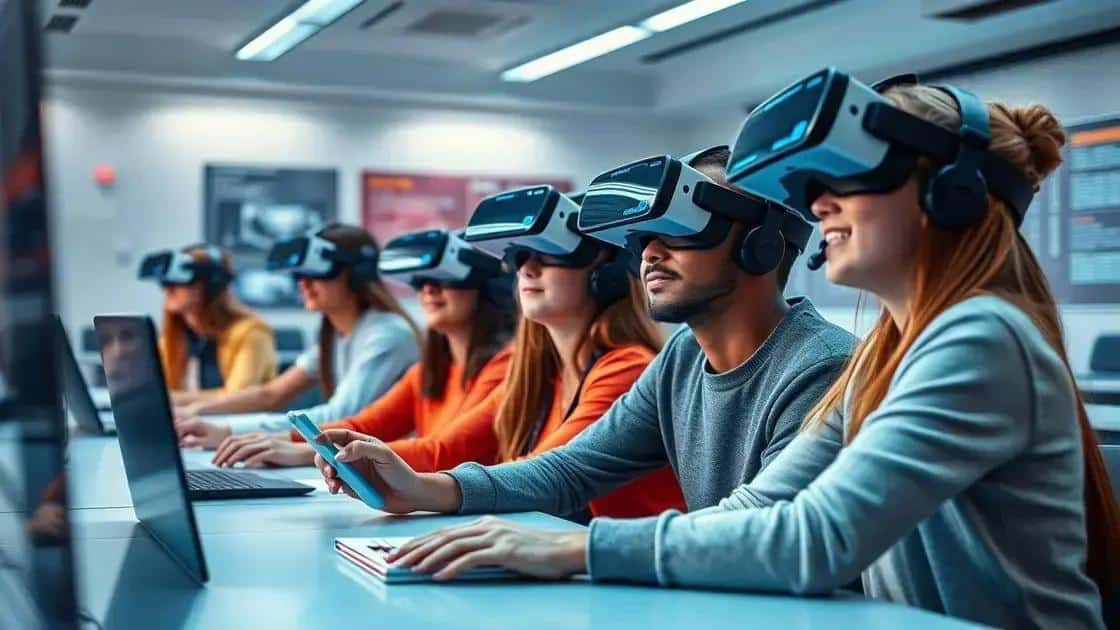
The future trends in virtual reality for education are exciting and full of potential. As technology advances, VR learning environments will evolve, providing richer experiences for students.
One major trend is the increased integration of artificial intelligence with VR. This combination will allow for more personalized learning experiences. AI can adapt the content based on individual student performance, making lessons more effective.
Collaboration and Social Learning
Another trend is the enhancement of collaborative learning through VR. Students will be able to interact with each other in virtual spaces, regardless of their physical location. This opens up opportunities for group projects and discussions that once required a physical classroom.
- Global classrooms where students from different countries can learn together.
- Peer-to-peer tutoring in virtual settings.
- Workshops conducted by industry experts in immersive environments.
- Enriched group dynamics that can foster better teamwork skills.
As we move forward, we can also expect advances in user-friendly technology. New devices will be easier to use and more affordable. This will make VR learning environments accessible to a larger number of schools and students.
Furthermore, content creation is likely to become more streamlined. With tools allowing teachers to design their own VR lessons, customization will be key. This flexibility means that lessons can be closely aligned with curriculum standards and engage students more effectively.
Enhanced Accessibility
Accessibility features will be improved as well. VR technologies will evolve to include options for students with disabilities. This will provide more inclusive educational opportunities for all learners.
Overall, the trends in virtual reality for education indicate a shift towards more immersive, personalized, and collaborative learning experiences. As more educators embrace these tools, the future of education looks promising and innovative.
The integration of virtual reality in education is not just a trend; it’s a significant shift towards more engaging and effective learning experiences. By incorporating VR learning environments, educators will unlock new potential for collaboration, personalization, and inclusivity in the classroom. As technology evolves, so will opportunities for students to immerse themselves in interactive lessons that promote critical thinking and creativity. The future of education with VR looks bright and filled with possibilities!
FAQ – Frequently Asked Questions about VR in Education
What are the main benefits of using VR in classrooms?
The main benefits include enhanced engagement, personalized learning experiences, and opportunities for global collaboration.
How does VR help with student retention of information?
VR provides immersive experiences that help students visualize complex ideas, leading to better memory recall.
What challenges do schools face when implementing VR technology?
Challenges include high costs, technical training for teachers, and the need for adequate physical space.
What are future trends for VR in education?
Future trends include increased AI integration, improved accessibility for students with disabilities, and advancements in collaborative learning.



